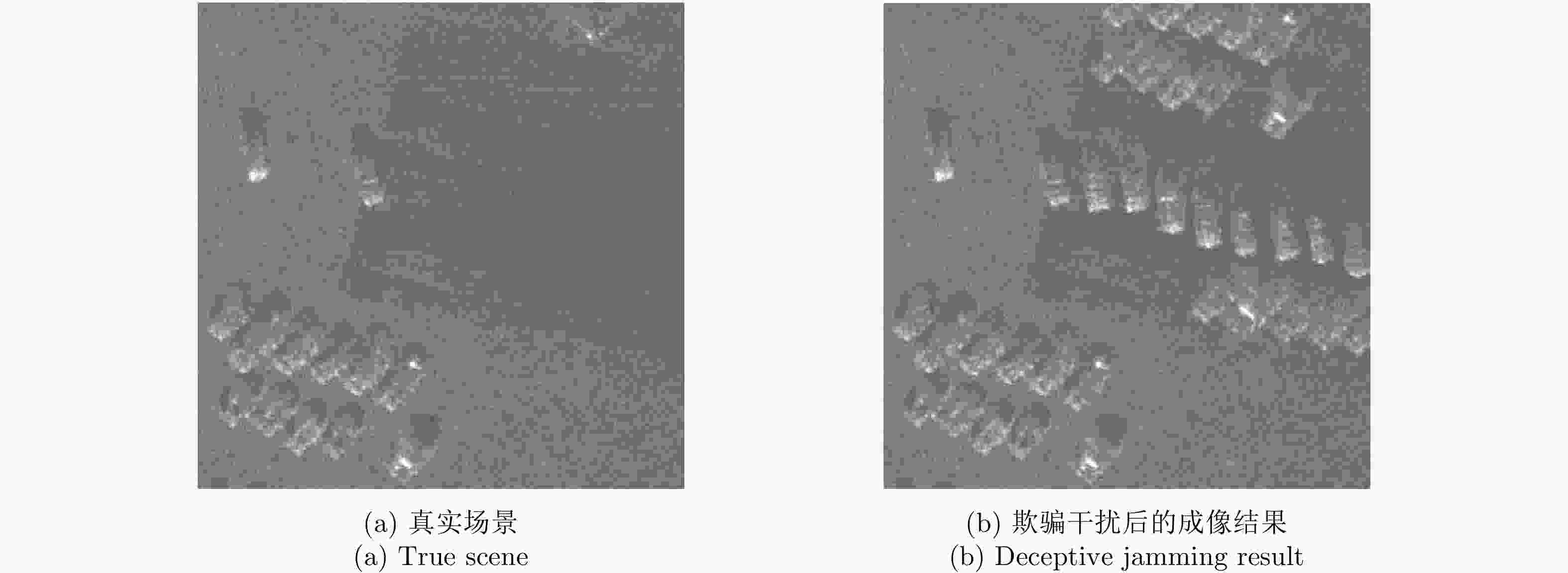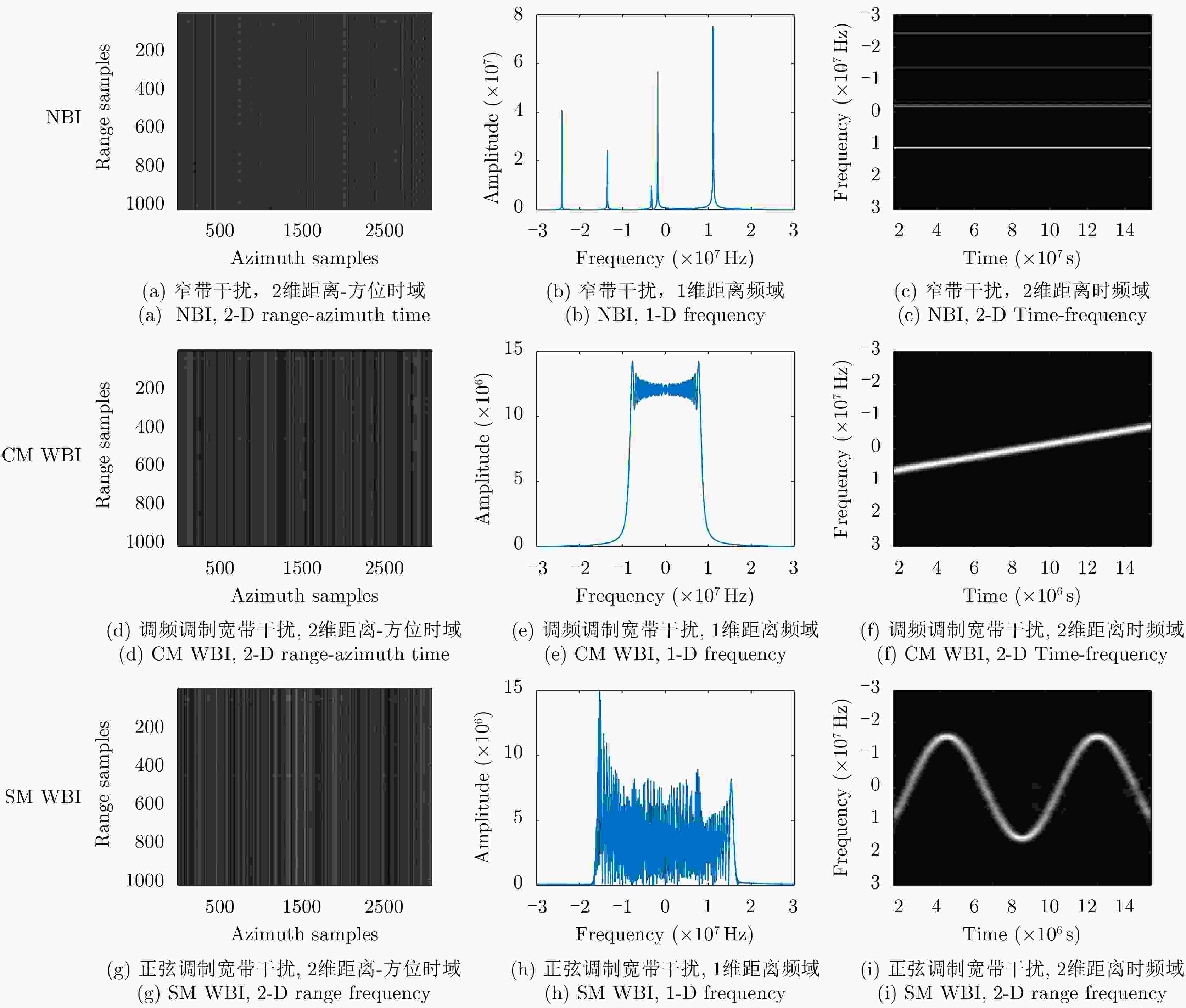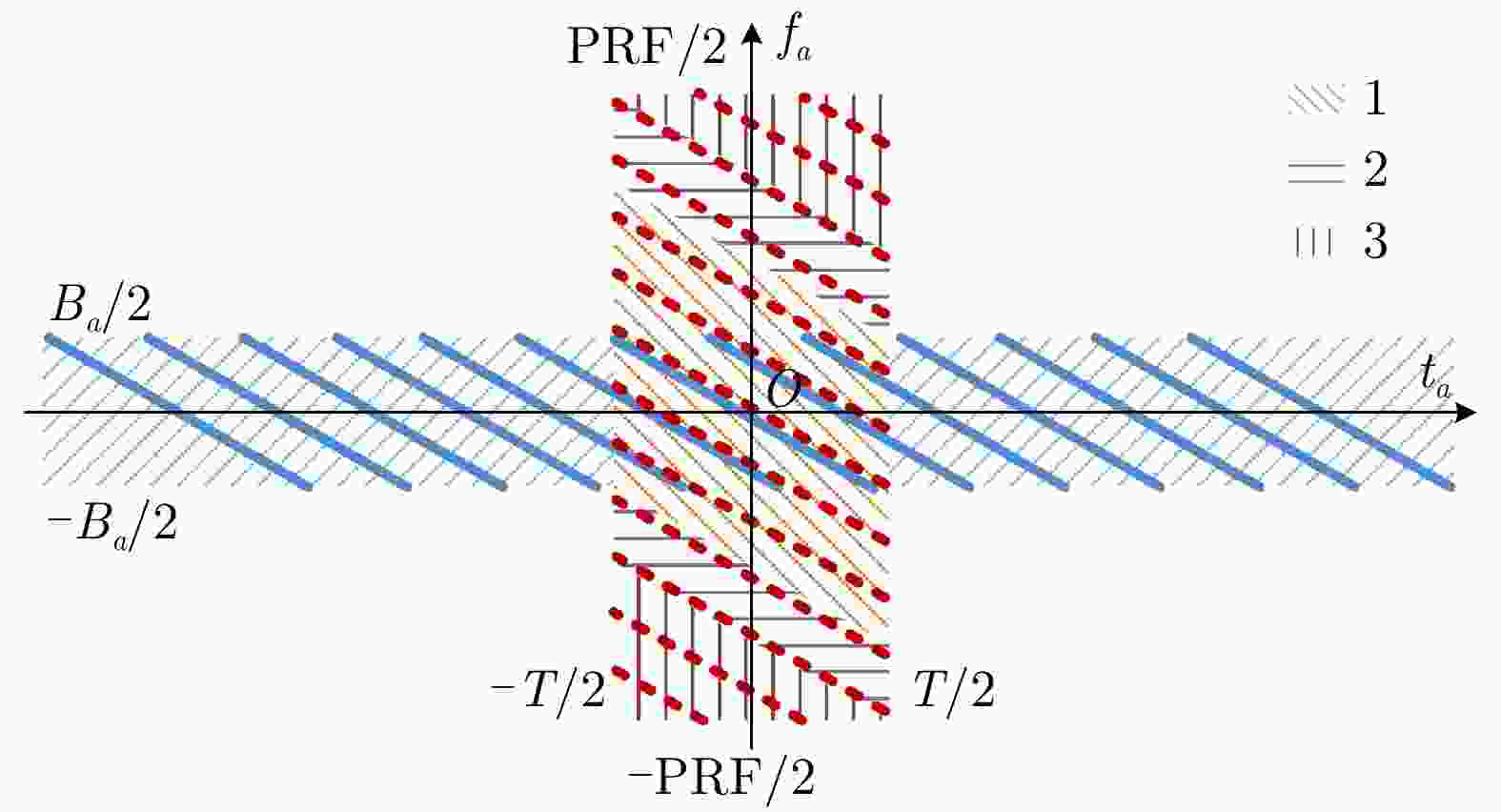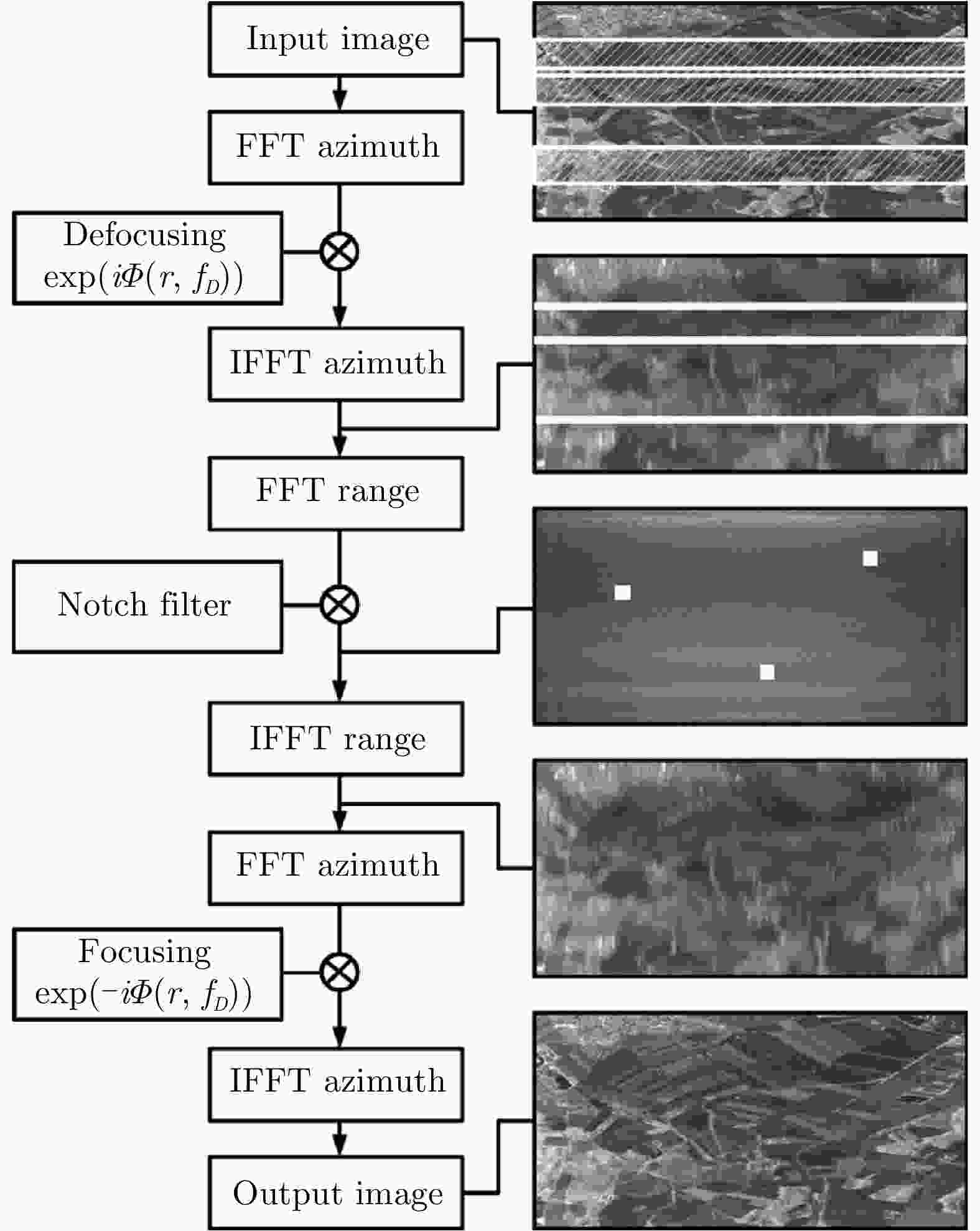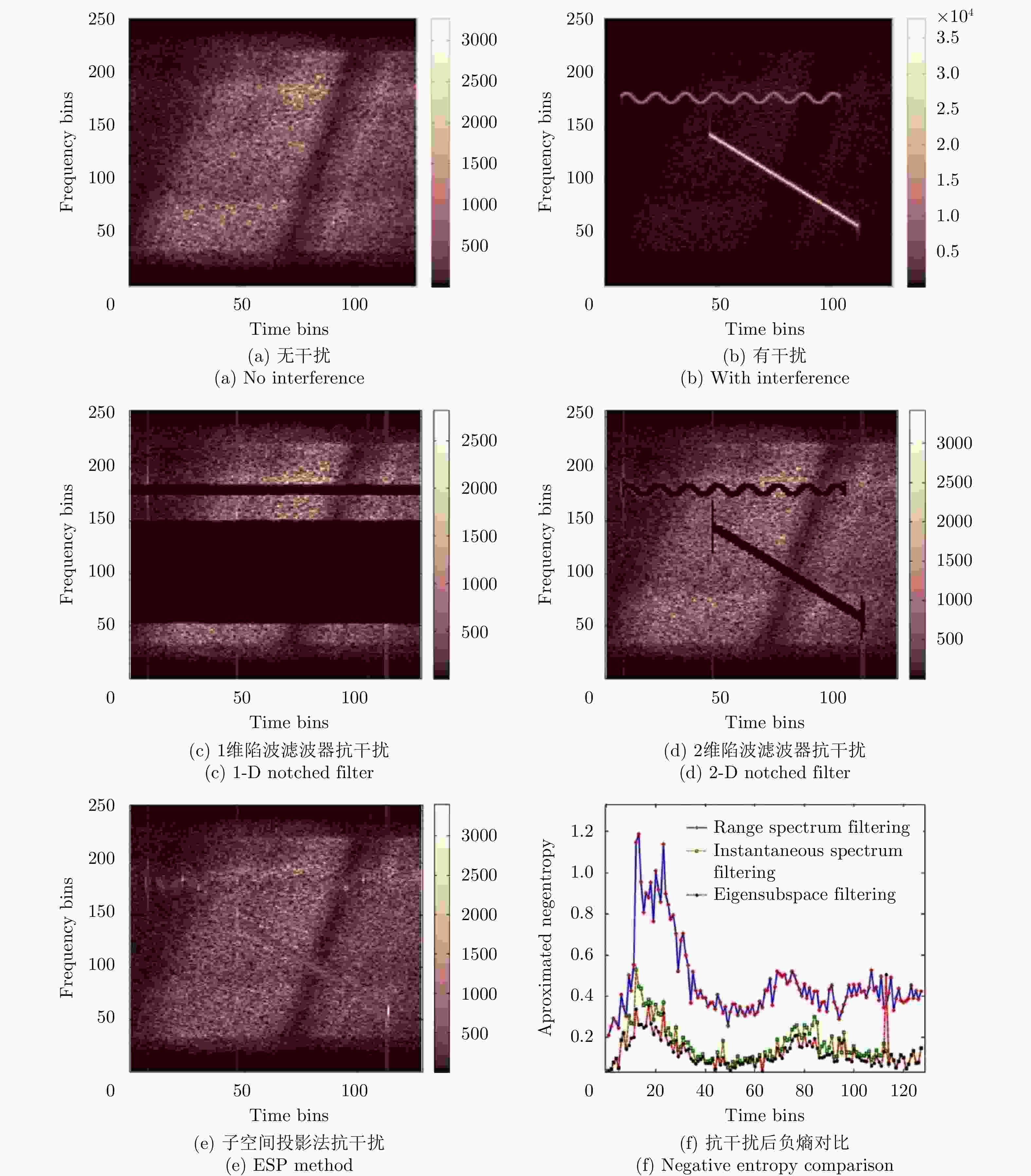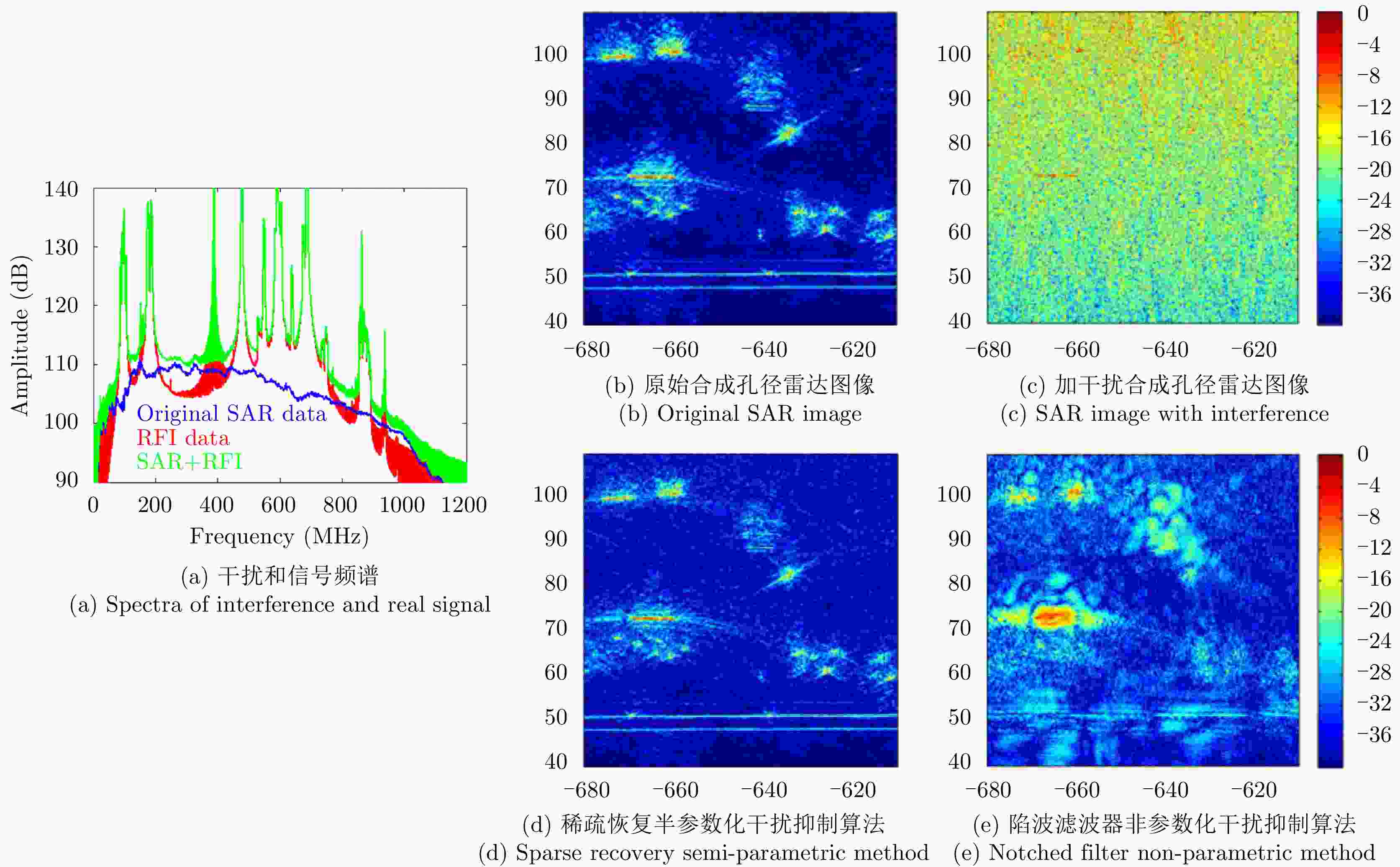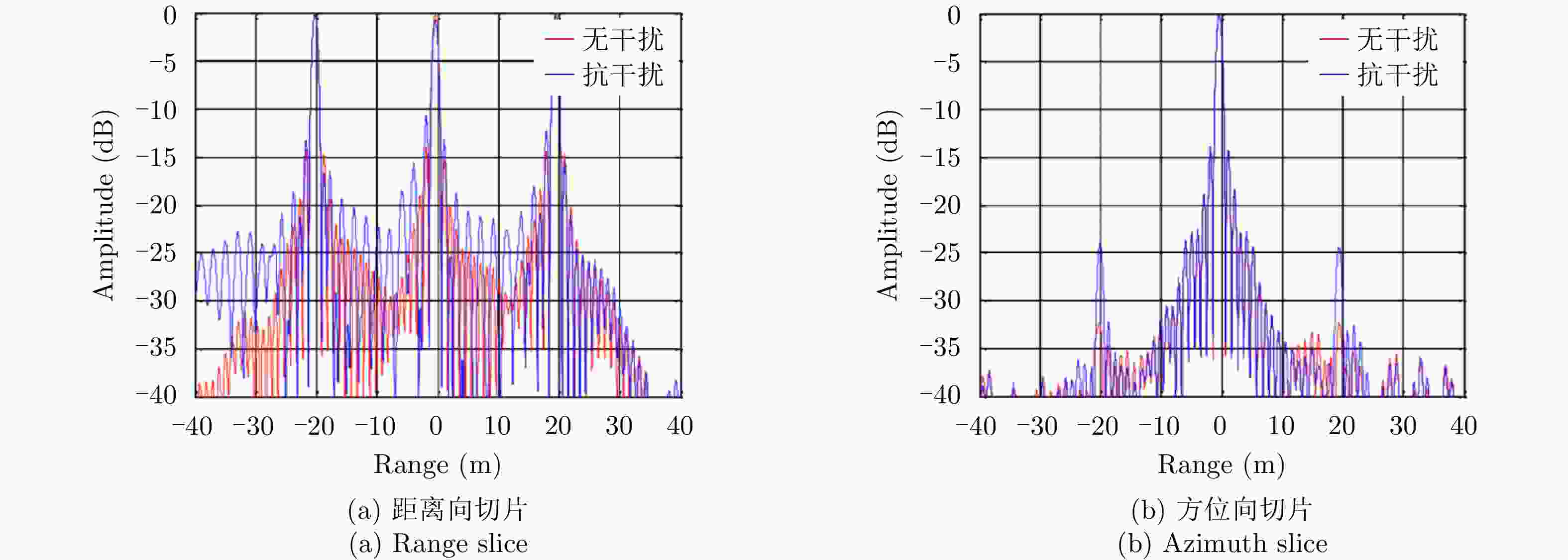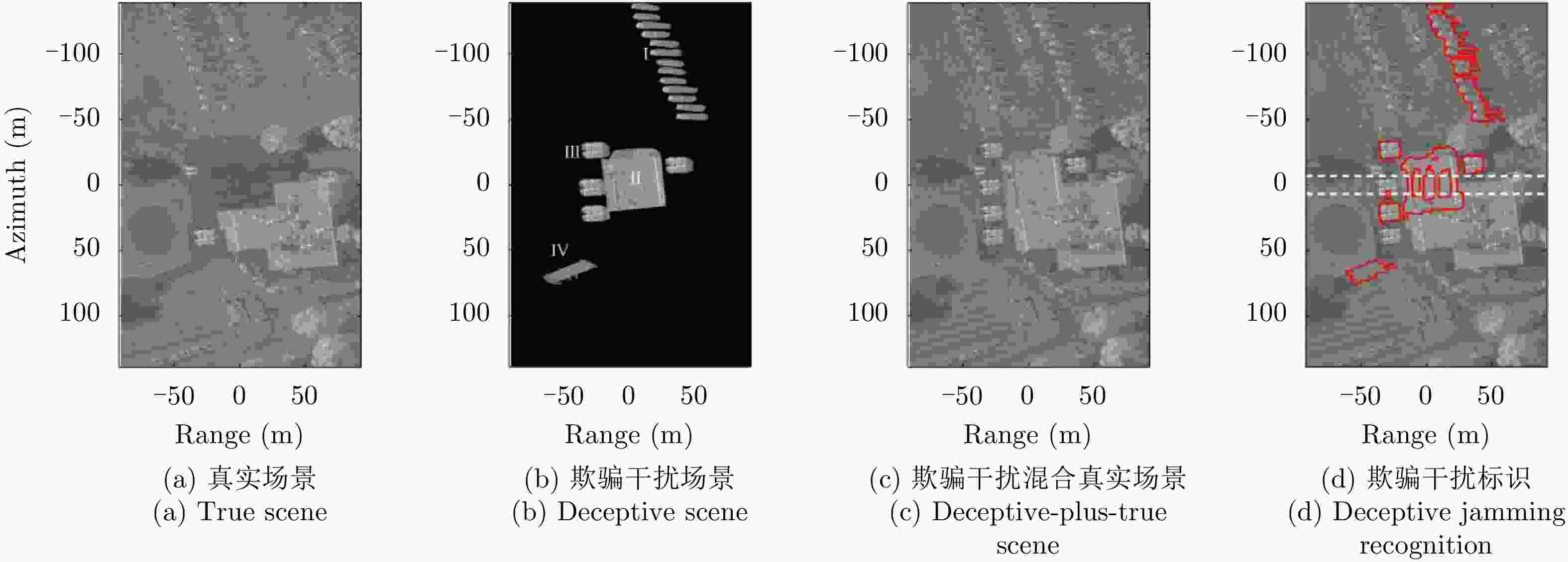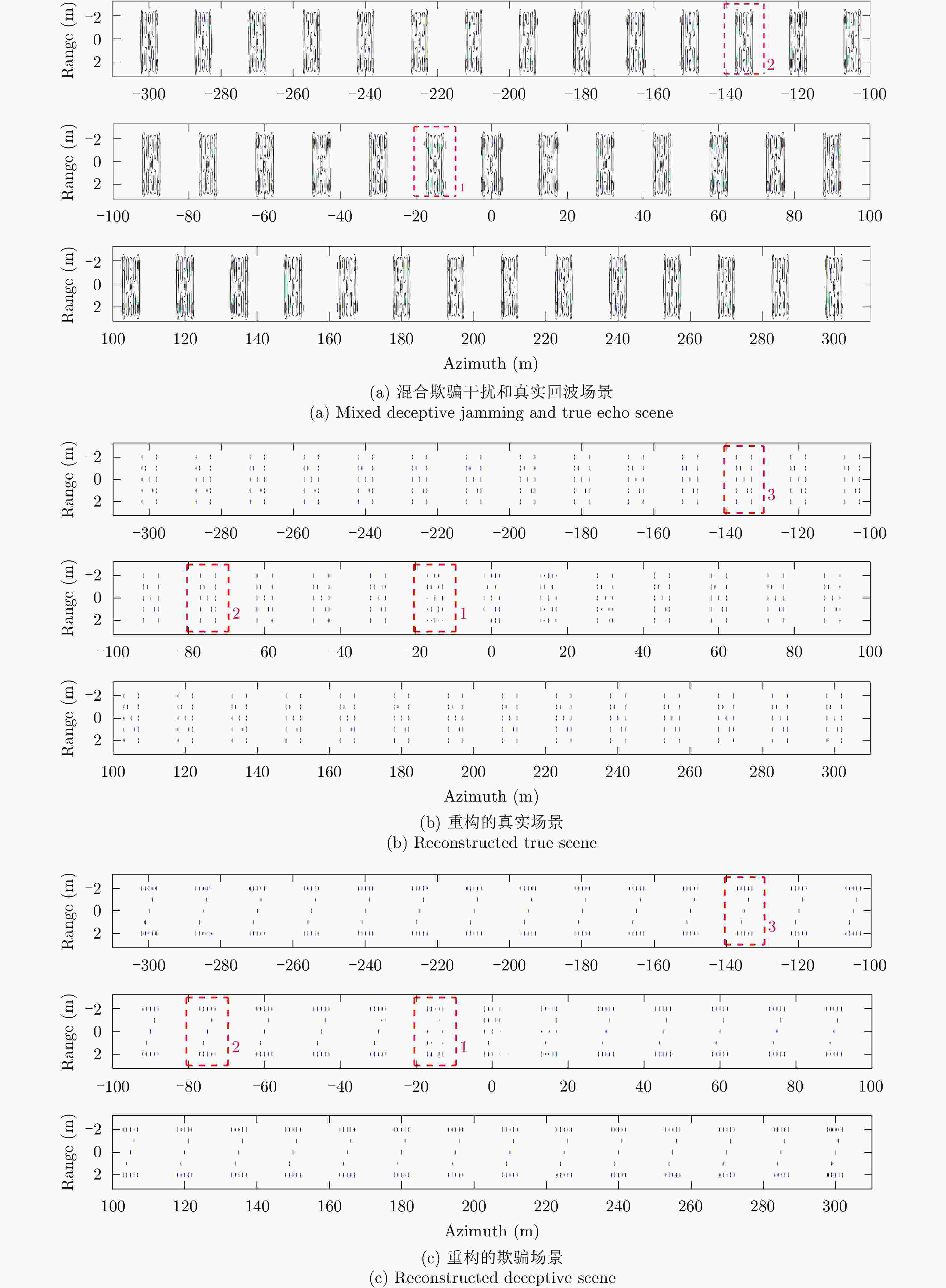-
摘要: 合成孔径雷达(SAR)得益于其全天时全天候、高分辨率的工作模式,在最近几十年吸引了全球雷达学者的目光。作为一种有源雷达系统,合成孔径雷达高分辨成像过程中会受多样式复杂多变的强电磁干扰影响,从而严重影响合成孔径雷达最终的高分辨成像结果,因此,如何有效对抗复杂电磁干扰是合成孔径雷达探测感知的难点和重点之一。该文针对不同的干扰样式、干扰来源、干扰散射机理、雷达天线配置、目标特性等合成孔径雷达抗干扰及高分辨成像的关键要素和主要思路进行了总结梳理,并依照干扰对抗算法的本质,对近些年代表性的合成孔径雷达对抗压制干扰和欺骗干扰算法的文献进行介绍和归纳,旨在为以后的研究提供一定的参考。Abstract: Synthetic Aperture Radar (SAR) has attracted much attention in the recent decades owing to its all-weather and high-resolution working mode. As an active radar system, the high-resolution imaging process of SAR systems is affected by different types of strong, complex, and variable electromagnetic interferences that can severely affect the final high-resolution SAR imaging results. Thus, developing ways to effectively suppress complex electromagnetic interferences is a major challenge and focus of SAR detection. In this paper, we summarize the key elements and main concepts underlying interference suppression in high-resolution SAR imaging, including different interference patterns, interference sources, interference scattering mechanisms, radar antenna configurations, and target characteristics. We then consider the essential task of interference suppression algorithms. Recent papers that detail the representative SAR algorithms used to mitigate suppressed and deceptive jamming are introduced and summarized to provide references for future research.
-
表 1 现有抗单一类型孤立干扰方法优缺点对比(*表示最优)
Table 1. Comparison of isolated interference suppression methods (* denotes optimal)
非参数化方法 参数化方法 半参数化方法 计算复杂度 低* 高 较高 性能 差 较差 好* 真实信号保护项 无 无 有* 参数 无* 有(模型参数) 有(超参数) 性能依赖条件 干扰足够强 干扰模型已知 超参数、优化模型 -
[1] HUANG Yan, LIAO Guisheng, XU Jingwei, et al. GMTI and parameter estimation via time-doppler chirp-varying approach for single-channel airborne SAR system[J]. IEEE Transactions on Geoscience and Remote Sensing, 2017, 55(8): 4367–4383. doi: 10.1109/TGRS.2017.2691742 [2] HUANG Yan, LIAO Guisheng, ZHANG Zhen, et al. SAR automatic target recognition using joint low-rank and sparse multiview denoising[J]. IEEE Geoscience and Remote Sensing Letters, 2018, 15(10): 1570–1574. [3] HUANG Yan, LIAO Guisheng, XU Jingwei, et al. GMTI and parameter estimation for MIMO SAR system via fast interferometry RPCA method[J]. IEEE Transactions on Geoscience and Remote Sensing, 2018, 56(3): 1774–1787. doi: 10.1109/TGRS.2017.2768243 [4] ZHANG Lei, QIAO Zhijun, XING Mengdao, et al. A robust motion compensation approach for UAV SAR imagery[J]. IEEE Transactions on Geoscience and Remote Sensing, 2012, 50(8): 3202–3218. doi: 10.1109/TGRS.2011.2180392 [5] ZHANG Lei, XING Mengdao, QIU Chengwei, et al. Resolution enhancement for inversed synthetic aperture radar imaging under low SNR via improved compressive sensing[J]. IEEE Transactions on Geoscience and Remote Sensing, 2010, 48(10): 3824–3838. doi: 10.1109/TGRS.2010.2048575 [6] XING Mengdao, JIANG Xiuwei, WU Renbiao, et al. Motion compensation for UAV SAR based on raw radar data[J]. IEEE Transactions on Geoscience and Remote Sensing, 2009, 47(8): 2870–2883. doi: 10.1109/TGRS.2009.2015657 [7] ZHANG Lei, HU Mengqi, WANG Guangyong, et al. Range-dependent map-drift algorithm for focusing UAV SAR imagery[J]. IEEE Geoscience and Remote Sensing Letters, 2016, 13(8): 1158–1162. doi: 10.1109/LGRS.2016.2574752 [8] XU Gang, GAO Yandong, LI Jinwei, et al. InSAR phase denoising: A review of current technologies and future directions[J]. IEEE Geoscience and Remote Sensing Magazine, 2020. doi: 10.1109/MGRS.2019.2955120 [9] WANG Guanyong, ZHANG Man, HUANG Yan, et al. Robust two-dimensional spatial-variant map-drift algorithm for UAV SAR autofocusing[J]. Remote Sensing, 2019, 11(3): 340. doi: 10.3390/rs11030340 [10] CHEN Zhanye, ZHOU Yu, ZHANG Linrang, et al. Ground moving target imaging and analysis for near-space hypersonic vehicle-borne synthetic aperture radar system with squint angle[J]. Remote Sensing, 2018, 10(12): 1966. doi: 10.3390/rs10121966 [11] WILEY C A. Synthetic aperture radars[J]. IEEE Transactions on Aerospace and Electronic Systems, 1985, AES-21(3): 440–443. doi: 10.1109/TAES.1985.310578 [12] CUTRONA L J, LEITH E N, PORCELLO L J, et al. On the application of coherent optical processing techniques to synthetic-aperture radar[J]. Proceedings of the IEEE, 1966, 54(8): 1026–1032. doi: 10.1109/PROC.1966.4987 [13] SHERWIN C W, RUINA J E, and RAWCLIFFE R D. Some early developments in synthetic aperture radar system[J]. IRE Transactions on Military Electronic, 1962, 6(2): 111–115. [14] CUMMING I G and WONG F H. Digital Processing of Synthetic Aperture Radar Data: Algorithms and Implementation[M]. Boston, MA, USA: Artech House, 2005. [15] 保铮, 邢孟道, 王彤. 雷达成像技术[M]. 北京: 电子工业出版社, 2005.BAO Zheng, XING Mengdao, and WANG Tong. Radar Imaging Technique[M]. Beijing: Publishing House of Electronics Industry, 2005. [16] 陶明亮. 极化SAR射频干扰抑制与地物分类方法研究[D]. [博士论文], 西安电子科技大学, 2016.TAO Mingliang. Research on radio frequency interference mitigation and land cover classification for PolSAR[D]. [Ph.D. dissertation], Xidian University, 2016. [17] 林晓烘. 星载合成孔径雷达干扰与抗干扰技术研究[D]. [博士论文], 国防科学技术大学, 2014.LIN Xiaohong. Study on jamming and anti-jamming techniques for spaceborne synthetic aperture radar[D]. [Ph.D. dissertation], National University of Defense Technology, 2014. [18] ZHOU Feng and TAO Mingliang. Research on methods for narrow-band interference suppression in synthetic aperture radar data[J]. IEEE Journal of Selected Topics in Applied Earth Observations and Remote Sensing, 2015, 8(7): 3476–3485. doi: 10.1109/JSTARS.2015.2431916 [19] 黄岩. 复杂电磁环境下合成孔径雷达动目标检测与识别方法研究[D]. [博士论文], 西安电子科技大学, 2018.HUANG Yan. Research on techniques of moving target detection and recognition for synthetic aperture radar in complex electromagnetism environment[D]. [Ph.D. dissertation], Xidian University, 2018. [20] SANDERS F H, SOLE R L, BEDFORD B L, et al. Effects of RF interference on radar receivers[R]. NTIA Report TR-06-444, 2006. [21] ZHAO Bo, ZHOU Feng, and BAO Zheng. Deception jamming for squint SAR based on multiple receivers[J]. IEEE Journal of Selected Topics in Applied Earth Observations and Remote Sensing, 2015, 8(8): 3988–3998. doi: 10.1109/JSTARS.2014.2322612 [22] ZHAO Bo, HUANG Lei, ZHOU Feng, et al. Performance improvement of deception jamming against SAR based on minimum condition number[J]. IEEE Journal of Selected Topics in Applied Earth Observations and Remote Sensing, 2017, 10(3): 1039–1055. doi: 10.1109/JSTARS.2016.2614957 [23] 张永顺, 童宁宁, 赵国庆. 雷达电子战原理[M]. 北京: 国防工业出版社, 2006.ZHANG Yongshun, TONG Ningning, and ZHAO Guoqing. Principle of Radar Electronic Warfare[M]. Beijing: National Defense Industry Publishing House, 2006. [24] 袁文先, 杨巧玲. 百年电子战[M]. 北京: 军事科学出版社, 2008.YUAN Wenxian and YANG Qiaoling. Electronic Warfare for A Century[M]. Beijing: Military Science Publishing House, 2008. [25] 赵国庆. 雷达对抗原理[M]. 西安: 西安电子科技大学出版社, 1999.ZHAO Guoqing. Principle of Radar Countermeasure[M]. Xi’an: Xidian University Publishing House, 1999. [26] TAO Mingliang, ZHOU Feng, and ZHANG Zijing. Characterization and mitigation of radio frequency interference in PolSAR data[J]. Radio Science, 2017, 52(11): 1405–1418. doi: 10.1002/2017RS006252 [27] 何发远, 谢明, 吴晓红, 等. 一种星载SAR图像欺骗式干扰技术[J]. 四川大学学报: 自然科学版, 2009, 46(4): 993–998.HE Fayuan, XIE Ming, WU Xiaohong, et al. A technology of deceiving jamming for space born SAR images[J]. Journal of Sichuan University:Natural Science Edition, 2009, 46(4): 993–998. [28] 高晓平, 雷武虎. SAR散射波干扰实现方法的研究[J]. 现代雷达, 2006, 28(8): 22–24, 42. doi: 10.3969/j.issn.1004-7859.2006.08.007GAO Xiaoping and LEI Wuhu. Method of implementing scatter-wave jamming signal to SAR[J]. Modern Radar, 2006, 28(8): 22–24, 42. doi: 10.3969/j.issn.1004-7859.2006.08.007 [29] 李伟. 分布式星载SAR干扰与抗干扰研究[D]. [博士论文], 国防科学技术大学, 2006.LI Wei. Research on technology of distributed Spaceborne SAR jamming and anti-jamming[D]. [Ph.D. dissertation], National University of Defense Technology, 2006. [30] 张云鹏, 毕大平, 周阳, 等. 余弦调相散射波干扰对SAR双通道对消干扰抑制的影响[J]. 遥感学报, 2019, 23(1): 99–107.ZHANG Yunpeng, BI Daping, ZHOU Yang, et al. Effect of cosinusoidal phase-modulated scatter-wave jamming to the jamming suppression of SAR dual-channel cancellation[J]. Journal of Remote Sensing, 2019, 23(1): 99–107. [31] 甘荣兵, 王建国, 何川. 双路对消抑制对合成孔径雷达的弹射式干扰[J]. 信号处理, 2005, 21(1): 27–30. doi: 10.3969/j.issn.1003-0530.2005.01.006GAN Rongbing, WANG Jianguo, and HE Chuan. Rebound jamming suppression by two-channel SAR[J]. Signal Processing, 2005, 21(1): 27–30. doi: 10.3969/j.issn.1003-0530.2005.01.006 [32] 甘荣兵, 王建国, 何川. 双天线对消弹射式干扰中的相位估计[J]. 电子学报, 2005, 33(9): 1691–1693. doi: 10.3321/j.issn:0372-2112.2005.09.037GAN Rongbing, WANG Jianguo, and HE Chuan. Phase estimation in rebound jamming suppression by two-channel SAR[J]. Acta Electronica Sinica, 2005, 33(9): 1691–1693. doi: 10.3321/j.issn:0372-2112.2005.09.037 [33] HUANG Yan, LAN Lan, ZHANG Lei, et al. Simultaneous narrowband and wideband interference suppression on single-channel SAR system via low-rank recovery[C]. 2019 IEEE International Geoscience and Remote Sensing Symposium, Yokohama, Japan, 2019: 600–603. [34] HUANG Yan, ZHANG Lei, LI Jie, et al. A novel tensor technique for simultaneous narrowband and wideband interference suppression on single-channel SAR system[J]. IEEE Transactions on Geoscience and Remote Sensing, 2019, 57(12): 9575–9588. doi: 10.1109/TGRS.2019.2927764 [35] FAN Weiwei, ZHOU Feng, TAO Mingliang, et al. Interference mitigation for synthetic aperture radar based on deep residual network[J]. Remote Sensing, 2019, 11(14): 1654. doi: 10.3390/rs11141654 [36] ZHOU Feng, ZHAO Bo, TAO Mingliang, et al. A large scene deceptive jamming method for space-borne SAR[J]. IEEE Transactions on Geoscience and Remote Sensing, 2013, 51(8): 4486–4495. doi: 10.1109/TGRS.2013.2259178 [37] ZHAO Bo, ZHOU Feng, SHI Xiaoran, et al. Multiple targets deception jamming against ISAR using electromagnetic properties[J]. IEEE Sensors Journal, 2015, 15(4): 2031–2038. doi: 10.1109/JSEN.2014.2368985 [38] CAZZANIGA G and GUARNIERI A M. Removing RF interferences from P-band airplane SAR data[C]. 1996 International Geoscience and Remote Sensing Symposium, Lincoln, USA, 1996: 1845–1847. [39] BUCKREUSS S and HORN R. E-SAR P-band SAR subsystem design and RF-interference suppression[C]. The Sensing and Managing the Environment. 1998 IEEE International Geoscience and Remote Sensing Symposium Proceedings, Seattle, USA, 1998: 466–468. [40] MEYER F J, NICOLL J B, and DOULGERIS A P. Correction and characterization of radio frequency interference signatures in L-band synthetic aperture radar data[J]. IEEE Transactions on Geoscience and Remote Sensing, 2013, 51(10): 4961–4972. doi: 10.1109/TGRS.2013.2252469 [41] ITU-R Recommendation RS. Mitigation technique to facilitate the use of the 1 215-1 300 MHz band by the earth exploration-satellite service (Active) and the space research service (Active)[EB/OL] https://www.itu.int/rec/R-REC-RS.1749/en, 2006. [42] NABIL H, CHEN Jie, KAMEL H, et al. Bidirectional notch filter for suppressing pulse modulated radio-frequency-interference in SAR data[C]. 2014 IEEE Geoscience and Remote Sensing Symposium, Quebec City, Canada, 2014: 1136–1139. [43] FENG Jin, ZHENG Huifang, DENG Yunkai, et al. Application of subband spectral cancellation for SAR narrow-band interference suppression[J]. IEEE Geoscience and Remote Sensing Letters, 2012, 9(2): 190–193. doi: 10.1109/LGRS.2011.2163150 [44] REIGBER A and FERRO-FAMIL L. Interference suppression in synthesized SAR images[J]. IEEE Geoscience and Remote Sensing Letters, 2005, 2(1): 45–49. doi: 10.1109/LGRS.2004.838419 [45] DOERRY A W. Apodized RFI filtering of synthetic aperture radar images[R]. Sandia Report SAND2014-1376, 2014. [46] NATSUAKI R, MOTOHKA T, WATANABE M, et al. An autocorrelation-based radio frequency interference detection and removal method in azimuth-frequency domain for SAR image[J]. IEEE Journal of Selected Topics in Applied Earth Observations and Remote Sensing, 2017, 10(12): 5736–5751. doi: 10.1109/JSTARS.2017.2775205 [47] DAVIS M E. Frequency allocation challenges for ultra-wideband radars[J]. IEEE Aerospace and Electronic Systems Magazine, 2013, 28(7): 12–18. doi: 10.1109/MAES.2013.6559376 [48] PINHEIRO M, RODRIGUEZ-CASSOLA M, PRATS-IRAOLA P, et al. Reconstruction of coherent pairs of synthetic aperture radar data acquired in interrupted mode[J]. IEEE Transactions on Geoscience and Remote Sensing, 2015, 53(4): 1876–1893. doi: 10.1109/TGRS.2014.2350255 [49] MUSGROVE C and WEST J C. Application of equalization notch to improve synthetic aperture radar coherent data products[C]. The Radar Sensor Technology XIX; and Active and Passive Signatures VI, Baltimore, United States, 2015: 94610T. [50] MUSGROVE C H and WEST J C. Mitigating effects of missing data for SAR coherent images[J]. IEEE Transactions on Aerospace and Electronic Systems, 2017, 53(2): 716–721. doi: 10.1109/TAES.2017.2664558 [51] MUSGROVE C H and WEST J C. Replacing missing data between airborne SAR coherent image pairs[J]. IEEE Transactions on Aerospace and Electronic Systems, 2017, 53(6): 3150–3158. doi: 10.1109/TAES.2017.2733860 [52] LE C T C, HENSLEY S, and CHAPIN E. Removal of RFI in wideband radars[C]. IGARSS’98. Sensing and Managing the Environment. 1998 IEEE International Geoscience and Remote Sensing Symposium Proceedings, Seattle, USA, 1998: 2032–2034. [53] LE C T, HENSLEY S, and CHAPIN E. Adaptive filtering of RFI in wideband SAR signals[C]. The 7th Annual JPL AirSAR Workshop, California, USA, 1998: 41–50. [54] POTIS A, UZUNOGLOU N, FRANGOS P, et al. Analysis of P-band synthetic aperture radar for airborne and spaceborne applications[R]. National Technical University of Athens (Greece), Department of Electrical and Computer Engineering, 2000. [55] POTSIS A, REIGBER A, PAPATHANASSIOU K P, et al. A phase preserving method for RF interference suppression in P-band synthetic aperture radar interferometric data[C]. IEEE 1999 International Geoscience and Remote Sensing Symposium, Hamburg, Germany, 1999: 2655–2657. [56] ROSEN P A, HENSLEY S, and LE C. Observations and mitigation of RFI in ALOS PALSAR SAR data: Implications for the DESDynI mission[C]. 2008 IEEE Radar Conference, Rome, Italy, 2008: 1–6. [57] LORD R T and INGGS M R. Efficient RFI suppression in SAR using LMS adaptive filter integrated with range/Doppler algorithm[J]. Electronics Letters, 1999, 35(8): 629–630. doi: 10.1049/el:19990437 [58] LORD R T and INGGS M R. Efficient RFI suppression in SAR using a LMS adaptive filter with sidelobe suppression integrated with the range-doppler algorithm[C]. 1999 International Geoscience and Remote Sensing Symposium, Hamburg, Germany, 1999: 574–576. [59] LUO X, ULANDER L M H, ASKNE J, et al. RFI suppression in ultra-wideband SAR systems using LMS filters in frequency domain[J]. Electronics Letters, 2001, 37(4): 241–243. doi: 10.1049/el:20010153 [60] HARCKE L J and LE C T C. AirMOSS P-band RF interference experience[C]. 2014 IEEE Radar Conference, Cincinnati, USA, 2014: 761–764. [61] VU V T, SJÖGREN T K, PETTERSSON M I, et al. RFI suppression in ultrawideband SAR using an adaptive line enhancer[J]. IEEE Geoscience and Remote Sensing Letters, 2010, 7(4): 694–698. doi: 10.1109/LGRS.2010.2045633 [62] LAMONT-SMITH T, HILL R D, HAYWARD S D, et al. Filtering approaches for interference suppression in low‐frequency SAR[J]. IEE Proceedings-Radar, Sonar and Navigation, 2006, 153(4): 338–344. doi: 10.1049/ip-rsn:20050092 [63] ZHOU F, WU R B, XING M D, et al. Eigensubspace-based filtering with application in narrow-band interference suppression for SAR[J]. IEEE Geoscience and Remote Sensing Letters, 2007, 4(1): 75–79. doi: 10.1109/LGRS.2006.887033 [64] ZHOU Feng, TAO Mingliang, BAI Xueru, et al. Narrow-band interference suppression for SAR based on independent component analysis[J]. IEEE Transactions on Geoscience and Remote Sensing, 2013, 51(10): 4952–4960. doi: 10.1109/TGRS.2013.2244605 [65] ZHOU Feng, XING Mengdao, BAI Xueru, et al. Narrow-band interference suppression for SAR based on complex empirical mode decomposition[J]. IEEE Geoscience and Remote Sensing Letters, 2009, 6(3): 423–427. doi: 10.1109/LGRS.2009.2015340 [66] TAO Mingliang, ZHOU Feng, LIU Jianqiang, et al. Narrow-band interference mitigation for SAR using independent subspace analysis[J]. IEEE Transactions on Geoscience and Remote Sensing, 2014, 52(9): 5289–5301. doi: 10.1109/TGRS.2013.2287900 [67] TAO Mingliang, ZHOU Feng, ZHANG Zijing, et al. Wideband interference mitigation in high-resolution airborne synthetic aperture radar data[J]. IEEE Transactions on Geoscience and Remote Sensing, 2016, 54(1): 74–87. doi: 10.1109/TGRS.2015.2450754 [68] MILLER T R, MCCORKLE J W, and POTTER L C. Near-least-squares radio frequency interference suppression[C]. The Algorithms for Synthetic Aperture Radar Imagery II, Orlando, USA, 1995: 72–84. [69] HUANG X T and LIANG D N. Gradual RELAX algorithm for RFI suppression in UWB-SAR[J]. Electronics Letters, 1999, 35(22): 1916–1917. doi: 10.1049/el:19991347 [70] 黄晓涛, 梁甸农. 基于RELAX的UWB-SAR抑制RFI算法[J]. 国防科技大学学报, 2000, 22(2): 55–59. doi: 10.3969/j.issn.1001-2486.2000.02.013HUANG Xiaotao and LIANG Diannong. RFI suppression in UWB-SAR based on RELAX[J]. Journal of National University of Defense Technology, 2000, 22(2): 55–59. doi: 10.3969/j.issn.1001-2486.2000.02.013 [71] LIU Zhiling, LIAO Guisheng, and YANG Zhiwei. Time variant RFI suppression for SAR using iterative adaptive approach[J]. IEEE Geoscience and Remote Sensing Letters, 2013, 10(6): 1424–1428. doi: 10.1109/LGRS.2013.2259575 [72] YANG Zhiwei, DU Wentao, LIU Zhiling, et al. WBI suppression for SAR using iterative adaptive method[J]. IEEE Journal of Selected Topics in Applied Earth Observations and Remote Sensing, 2016, 9(3): 1008–1014. doi: 10.1109/JSTARS.2015.2470107 [73] DJUKANOVIĆ S, DAKOVIĆ M, THAYAPARAN T, et al. Method for non-stationary jammer suppression in noise radar systems[J]. IET Signal Processing, 2010, 4(3): 305–313. doi: 10.1049/iet-spr.2009.0034 [74] DJUKANOVIC S and POPOVIC V. A parametric method for multicomponent interference suppression in noise radars[J]. IEEE Transactions on Aerospace and Electronic Systems, 2012, 48(3): 2730–2738. doi: 10.1109/TAES.2012.6237624 [75] ZHANG Shuangxi, XING Mengdao, GUO Rui, et al. Interference suppression algorithm for SAR based on time-frequency transform[J]. IEEE Transactions on Geoscience and Remote Sensing, 2011, 49(10): 3765–3779. doi: 10.1109/TGRS.2011.2164409 [76] NGUYEN L H, TRAN T, and DO T. Sparse models and sparse recovery for ultra-wideband SAR applications[J]. IEEE Transactions on Aerospace and Electronic Systems, 2014, 50(2): 940–958. doi: 10.1109/TAES.2014.120454 [77] NGUYEN L H and TRAN T D. Efficient and robust RFI extraction via sparse recovery[J]. IEEE Journal of Selected Topics in Applied Earth Observations and Remote Sensing, 2016, 9(6): 2104–2117. doi: 10.1109/JSTARS.2016.2528884 [78] LIU Hongqing, LI Dong, ZHOU Yi, et al. Joint wideband interference suppression and SAR signal recovery based on sparse representations[J]. IEEE Geoscience and Remote Sensing Letters, 2017, 14(9): 1542–1546. doi: 10.1109/LGRS.2017.2721425 [79] LIU Hongqing and LI Dong. RFI suppression based on sparse frequency estimation for SAR imaging[J]. IEEE Geoscience and Remote Sensing Letters, 2016, 13(1): 63–67. doi: 10.1109/LGRS.2015.2496620 [80] NGUYEN L H, DAO M D, and TRAN T D. Joint sparse and low-rank model for radio-frequency interference suppression in ultra-wideband radar applications[C]. 2014 48th Asilomar Conference on Signals, Systems and Computers, Pacific Grove, USA, 2014: 864–868. [81] JOY S, NGUYEN L H, and TRAN T D. Radio frequency interference suppression in ultra-wideband synthetic aperture radar using range-azimuth sparse and low-rank model[C]. 2016 IEEE Radar Conference, Philadelphia, USA, 2016: 1–4. [82] NGUYEN L H and TRAN T D. RFI-radar signal separation via simultaneous low-rank and sparse recovery[C]. 2016 IEEE Radar Conference, Philadelphia, USA, 2016: 1–5. [83] SU Jia, TAO Haihong, TAO Mingliang, et al. Narrow-band interference suppression via RPCA-based signal separation in time-frequency domain[J]. IEEE Journal of Selected Topics in Applied Earth Observations and Remote Sensing, 2017, 10(11): 5016–5025. doi: 10.1109/JSTARS.2017.2727520 [84] HUANG Yan, LIAO Guisheng, LI Jie, et al. Narrowband RFI suppression for SAR system via fast implementation of joint sparsity and low-rank property[J]. IEEE Transactions on Geoscience and Remote Sensing, 2018, 56(5): 2748–2761. doi: 10.1109/TGRS.2017.2782682 [85] HUANG Yan, LIAO Guisheng, XIANG Yijian, et al. Reweighted nuclear norm and reweighted Frobenius norm minimizations for narrowband RFI suppression on SAR system[J]. IEEE Transactions on Geoscience and Remote Sensing, 2019, 57(8): 5949–5962. doi: 10.1109/TGRS.2019.2903579 [86] HUANG Yan, LIAO Guisheng, ZHANG Zhen, et al. Fast narrowband RFI suppression algorithms for SAR systems via matrix-factorization techniques[J]. IEEE Transactions on Geoscience and Remote Sensing, 2019, 57(1): 250–262. doi: 10.1109/TGRS.2018.2853556 [87] HUANG Yan, LIAO Guisheng, ZHANG Lei, et al. Efficient narrowband RFI mitigation algorithms for SAR systems with reweighted tensor structures[J]. IEEE Transactions on Geoscience and Remote Sensing, 2019, 57(11): 9396–9409. doi: 10.1109/TGRS.2019.2926440 [88] HUANG Yan, LIAO Guisheng, XU Jingwei, et al. Narrowband RFI suppression for SAR system via efficient parameter-free decomposition algorithm[J]. IEEE Transactions on Geoscience and Remote Sensing, 2018, 56(6): 3311–3322. doi: 10.1109/TGRS.2018.2797946 [89] 张双喜, 孙光才, 刘艳阳, 等. 基于四通道SAR欺骗式干扰抑制算法[J]. 现代雷达, 2011, 33(2): 22–26, 30. doi: 10.3969/j.issn.1004-7859.2011.02.006ZHANG Shuangxi, SUN Guangcai, LIU Yanyang, et al. Deception interference supression algorithm based on four-channel for SAR[J]. Modern Radar, 2011, 33(2): 22–26, 30. doi: 10.3969/j.issn.1004-7859.2011.02.006 [90] LI Chen and ZHU Daiyin. The detection of deception jamming against SAR based on dual-aperture antenna cross-track interferometry[C]. 2006 CIE International Conference on Radar, Shanghai, China, 2006: 1–4. [91] SUN Bingzhang and LI Jingwen. A new interference elimination method for multi-satellite SAR system[C]. 2008 IEEE International Geoscience and Remote Sensing Symposium, Boston, USA, 2008: IV-1316–IV-1319. [92] 于春锐. 合成孔径雷达有源干扰抑制技术研究[D]. [博士论文], 国防科学技术大学, 2012.YU Chunrui. Study on active interference suppression for synthetic aperture radar[D]. [Ph.D. dissertation], National University of Defense Technology, 2012. [93] 郭睿, 孙光才, 王玉, 等. 极化SAR中的有源干扰抑制分析[J]. 宇航学报, 2011, 32(6): 1365–1372. doi: 10.3873/j.issn.1000-1328.2011.06.025GUO Rui, SUN Guangcai, WANG Yu, et al. Analysis of the active jamming suppression in polarimetric SAR[J]. Journal of Astronautics, 2011, 32(6): 1365–1372. doi: 10.3873/j.issn.1000-1328.2011.06.025 [94] FENG Qingqing, XU Huaping, WU Zhefeng, et al. Deceptive jamming suppression for SAR based on time-varying initial phase[C]. 2016 IEEE International Geoscience and Remote Sensing Symposium, Beijing, China, 2016: 4996–4999. [95] 赵宗锋. 基于信号波形设计的SAR抗干扰技术研究[D]. [硕士论文], 国防科学技术大学, 2007.ZHAO Zongfeng. SAR anti-jamming based on waveform design[D]. [Master dissertation], National University of Defense Technology, 2007. [96] 李江源, 王建国. 利用复杂调制LFM信号的SAR抗欺骗干扰技术[J]. 电子与信息学报, 2008, 30(9): 2111–2114. doi: 10.3724/SP.J.1146.2007.00231LI Jiangyuan and WANG Jianguo. The anti-jamming technology for SAR cheat jamming using complex modulated LFM signal[J]. Journal of Electronics &Information Technology, 2008, 30(9): 2111–2114. doi: 10.3724/SP.J.1146.2007.00231 [97] 冯祥芝, 许小剑. 随机线性调频斜率SAR抗欺骗干扰方法研究[J]. 系统工程与电子技术, 2009, 31(1): 69–73. doi: 10.3321/j.issn:1001-506X.2009.01.018FENG Xiangzhi and XU Xiaojian. Study of countermeasures to deceptive jamming using random linear modulation frequency ratio SAR[J]. Systems Engineering and Electronics, 2009, 31(1): 69–73. doi: 10.3321/j.issn:1001-506X.2009.01.018 [98] LI Yuntao, JIA Xin, CHEN Yongguang, et al. Frequency agility MIMO-SAR imaging and anti-deception jamming performance[C]. 2014 31th URSI General Assembly and Scientific Symposium, Beijing, China, 2014: 1–4. [99] 贾宝京. SAR欺骗干扰抑制和目标高分辨成像方法的研究[D]. [硕士论文], 燕山大学, 2015.JIA Baojing. Study on SAR confronting deception jamming and high resolution imaging[D]. [Master dissertation], Yanshan University, 2015. [100] LIU Yongcai, WANG Wei, PAN Xiaoyi, et al. Inverse omega-K algorithm for the electromagnetic deception of synthetic aperture radar[J]. IEEE Journal of Selected Topics in Applied Earth Observations and Remote Sensing, 2016, 9(7): 3037–3049. doi: 10.1109/JSTARS.2016.2543961 [101] ZHAO Bo, HUANG Lei, LI Jian, et al. Deceptive SAR jamming based on 1-bit sampling and time-varying thresholds[J]. IEEE Journal of Selected Topics in Applied Earth Observations and Remote Sensing, 2018, 11(3): 939–950. doi: 10.1109/JSTARS.2018.2793247 [102] LUO Shuangcai, XIONG Ying, CHENG Hao, et al. An algorithm of radar deception jamming suppression based on blind signal separation[C]. 2011 International Conference on Computational Problem-Solving, Chengdu, China, 2011: 167–170. [103] ZHAO Bo, HUANG Lei, HE Chunlong, et al. SAR deception jamming identification via differential feature enhancement[C]. 2016 CIE International Conference on Radar, Guangzhou, China, 2016: 1–5. [104] SHI Xiaoran, ZHOU Feng, ZHAO Bo, et al. Deception jamming method based on micro-Doppler effect for vehicle target[J]. IET Radar, Sonar & Navigation, 2016, 10(6): 1071–1079. [105] ZHAO Bo, HUANG Lei, and ZHANG Jihong. Single channel SAR deception jamming suppression via dynamic aperture processing[J]. IEEE Sensors Journal, 2017, 17(13): 4225–4230. doi: 10.1109/JSEN.2017.2695001 [106] ZHAO Bo, HUANG Lei, LI Jian, et al. Target reconstruction from deceptively jammed single-channel SAR[J]. IEEE Transactions on Geoscience and Remote Sensing, 2018, 56(1): 152–167. doi: 10.1109/TGRS.2017.2744178 [107] ZHAO Bo, HUANG Lei, and SUN Weize. Target reconstruction in deceptively jammed SAR via ADMM[J]. IEEE Sensors Journal, 2019, 19(11): 4331–4339. doi: 10.1109/JSEN.2018.2873683 -



 作者中心
作者中心 专家审稿
专家审稿 责编办公
责编办公 编辑办公
编辑办公

 下载:
下载:
